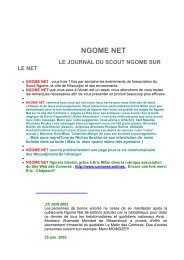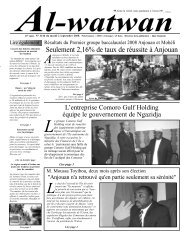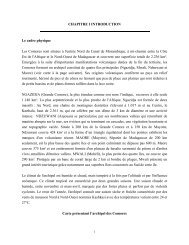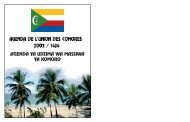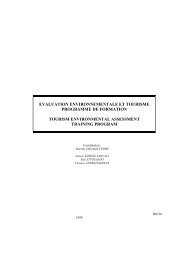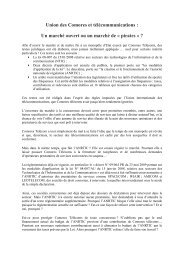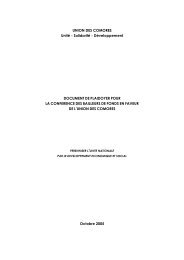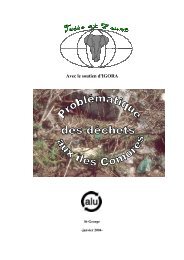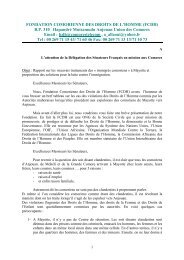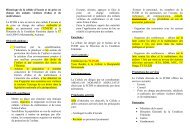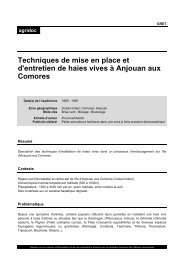Photo Bara7<strong>Gui<strong>de</strong></strong> économique Union <strong><strong>de</strong>s</strong> <strong>Comores</strong> 2003Données sectorielles (suite)g Le cas <strong><strong>de</strong>s</strong> cultures maraîchèresLes cultures maraîchèresdont la productions'est développée rapi<strong>de</strong>ment<strong>au</strong> cours <strong><strong>de</strong>s</strong><strong>de</strong>rnières années sontpresque exclusivementvendues sur les marchésurbains. Ces culturesbénéficient d'uneattention plus gran<strong><strong>de</strong>s</strong>ur le plan <strong><strong>de</strong>s</strong> techniques culturales car elles génèrent<strong><strong>de</strong>s</strong> revenus significatifs pour les producteurs.g Le cas <strong><strong>de</strong>s</strong> cultures vivrièresLes cultures vivrières (banane, manioc, taro, patatedouce, maïs, pois cajan, coco, fruits, etc.) sont <strong><strong>de</strong>s</strong>tinéesessentiellement à l'<strong>au</strong>to-consommation.g Le cas <strong>de</strong> l'élevageIl existe un embryon <strong>de</strong> secteur <strong>de</strong> l'élevage (bovins,caprins et volaille) qui est surtout développé à Mwali.L'élevage <strong>de</strong> la région <strong>de</strong> Nioumakélé sur l'île <strong>de</strong>Ndzuwani où l'amélioration génétique <strong>de</strong> la race localebovine a permis d'<strong>au</strong>gmenter la production laitière <strong><strong>de</strong>s</strong>vaches <strong>de</strong> 3 à 10 litres <strong>de</strong> lait par jour.Les principales forces sont les suivantes :h Les bonnes qualités génétiques <strong><strong>de</strong>s</strong> races localesh Les conditions sanitaires relativement bonnesh L'expertise <strong><strong>de</strong>s</strong> producteurs appréciable dans certainesrégions.g Le cas <strong>de</strong> la pêcheLa pêche côtière est une activité importante qui occupe9000 pêcheurs et génère 32000 emplois indirects. Les<strong>de</strong>rnières estimations <strong>de</strong> la Direction Générale <strong>de</strong> lapêche (2000) indiquent qu'entre 15 000 et 20 000 tonnes<strong>de</strong> poissons ont été capturées en 2000. Le secteur<strong>de</strong> la pêche figure pourtant parmi les secteurs prometteurssur le plan économique et pourrait contribuersignificativement à la réduction <strong>de</strong> la p<strong>au</strong>vreté. Lesréserves <strong>de</strong> poissons sont estimées à 50 000 tonnes etseraient exploitées à 26% <strong>de</strong> leur potentiel. Les réservesnon encore exploitées offrent un grand potentielmais sont <strong>au</strong> large pour la plupart. Leur exploitationexige <strong><strong>de</strong>s</strong> bate<strong>au</strong>x plus gros et mieux équipés‚ <strong><strong>de</strong>s</strong>dispositifs <strong>de</strong> sécurité <strong><strong>de</strong>s</strong> pêcheurs en mer et <strong><strong>de</strong>s</strong> capacités<strong>de</strong> stockage et <strong>de</strong> trans<strong>format</strong>ion appropriées.g Le cas <strong><strong>de</strong>s</strong> infrastructures routièresLa contribution <strong><strong>de</strong>s</strong> infrastructures routières à la croissanceéconomique et à la réduction <strong>de</strong> la p<strong>au</strong>vreté sontindéniables, dans la mesure où elles contribuent à <strong>au</strong>gmenterla circulation <strong><strong>de</strong>s</strong> biens et <strong><strong>de</strong>s</strong> personnes et àintensifier l'activité économique... Le rése<strong>au</strong> routiernational est assez <strong>de</strong>nse. Constitué <strong>de</strong> 553 km <strong>de</strong> routesbitumées et <strong>de</strong> 240 km <strong>de</strong> routes et pistes en terre,il couvre environ 80% du territoire national.Situation générale du rése<strong>au</strong> routier <strong><strong>de</strong>s</strong> <strong>Comores</strong>En général toutes les régions sont désenclavés.Le TourismeRoutesnationalesLe tourisme est l'une <strong><strong>de</strong>s</strong> potentialités économique <strong><strong>de</strong>s</strong><strong>Comores</strong>, bien qu'il ne soit pas suffisamment exploité.Le pays dispose d'un patrimoine naturel considérable,méritant d'être exploité. Il est à la fois un jardin botanicet un aquarium tropical. Des nombreux sites d'intérêtstouristique dont la plupart balnéaires, sont déjà i<strong>de</strong>ntifiésdans les trois îles <strong>de</strong> la lune. Les <strong>Comores</strong> sontconnus comme étant un sanctuaire <strong>de</strong> reptiles terrestreset d'oise<strong>au</strong>x en<strong>de</strong>miques tels que les "TWICHERS”.En ce qui concerne la f<strong>au</strong>ne terrestre on peut apprécierles roussettes <strong>de</strong> livingstone, les maquis et les globesmouches. Les espèces les plus remarquables sont lestortures <strong>de</strong> mer les dudongs et le Coelacanthe. Celui -citrès rare dans les <strong>au</strong>tres pays et <strong>de</strong>meure toujours unpatrimoine comorien. Les <strong>Comores</strong> représentent une<strong><strong>de</strong>s</strong>tination <strong>de</strong> choix à c<strong>au</strong>se <strong>de</strong> leurs paysages, <strong>de</strong> leurclimat <strong>de</strong> la qualité <strong>de</strong> la mer <strong>de</strong> la richesse, <strong>de</strong> la f<strong>au</strong>neet <strong>de</strong> la f<strong>au</strong>ne tropicale et <strong><strong>de</strong>s</strong> fonds sous marins.Les <strong>Comores</strong> disposent <strong>de</strong> 10 hôtels, 8 Motels et 9 pensions.Il se présente une large opportunité d'investirdans le domaine hôtelier Chaque île présente <strong><strong>de</strong>s</strong> siteset <strong><strong>de</strong>s</strong> valeurs touristiques particulières.Secteur <strong>de</strong> serviceRoutesrégionalesBitumée en terre Bitumée en terrePiste <strong>de</strong>désenclavementrestant à réaliserTotalMwali 69.4 12.9 15.4 2.0 16.5 116.2Ndzuwani 134.0 11.0 46.7 52.5 82.0 326.2Ngazidja 212.4 0.0 76.6 131.5 130.0 550.5<strong>Comores</strong> 415.8 23.9 138.7 186.0 228.5 992.9Pour le transport, <strong><strong>de</strong>s</strong> taxi affectés <strong>au</strong>près <strong><strong>de</strong>s</strong> aéroportet <strong><strong>de</strong>s</strong> grands hôtels. Des sociétés privées offrent <strong><strong>de</strong>s</strong>services <strong>de</strong> location <strong>de</strong> véhicule. En ce qui concerne lesassurances, il existe plusieurs sociétés privés en l'occurrenceAL AMANA, ACC ASSURANCES MORONI etCTI ASSURANCES qui opérent dans toutes les ILES.Pour ce qui est <strong>de</strong> la sécurité et du gardiennage, <strong><strong>de</strong>s</strong>sociétés spécialisées offrent leurs services <strong>au</strong>x sociétéscomme <strong>au</strong>x particuliers. Il existe <strong>de</strong> cabinets d'étu<strong><strong>de</strong>s</strong>,<strong>de</strong> conseil, comptable ou d'avocat pour les services d'étu<strong><strong>de</strong>s</strong>et conseils. En outre, <strong>de</strong> nombreux établissementspublics et privés dispensent <strong><strong>de</strong>s</strong> <strong>format</strong>ions enmatière <strong>de</strong> gestion, in<strong>format</strong>ique etc...
Photo BaraPhoto BaraPhoto BaraPhoto BaraUnion <strong><strong>de</strong>s</strong> <strong>Comores</strong> 2003<strong>Gui<strong>de</strong></strong> économique8Sectoral datas (suite)g Alimentation FarmingAlimentation farming (banana, manioc, taro, sweet patato,corn, pea, coco and fruit) is mainly for <strong>au</strong>toconsumption.g BreedingThere is a very small breeding sector (cattle, goats andpoultry), more <strong>de</strong>velopped in Mwali. Breeding in theNioumakele's region on Ndzuwani island, with the geneticimprovement of the local race of cows, has seen anincrease in milk production from 3 to 10 liters of milk aday.Main strengths of the sector are as follow:h Good genetic quality of the local breeds,h good sanitary conditions and,h producers significant knowledge in some regions.g Fishing IndustryCoastal fishing is animportant activitywhich employsalmost 9,000 fishermenand createsabout 32,000 indirectjobs. According tothe last estimatesfrom the FishingMinistry (DirectionGenerale <strong>de</strong> la Peche), between 15,000 and 20,000tons of fish were c<strong>au</strong>ght in the year 2000.The fishing sector is one of the most promising of theeconomic future and could contribute significantly to thereduction of the poverty. Fish reserves are estimated at50,000 tons. Only 26% of that estimate is exploited.Non exploited fishing reserves offer a large potential butmost of these reserves are in the open sea. Their exploitationwould require larger, well equipped boats, securityapparatus for the <strong>de</strong>ep sea fishermen, as well asappropriate storage and trans<strong>format</strong>ion facilities.g Road InfrastructureThe role of the road infrastructure on the economicgrowth and the poverty reduction are in<strong>de</strong>niable in asmuch as they contribute to the increase in the traffic ofgoods and people and to the intensification of the economicactivity.TourismAlthough tourism isnot fully exploited , itremains one of theeconomic potentialsof the Comoros. Thecountry has a consi<strong>de</strong>rablenatural heritagewhich needs tobe exploited. It isboth a botanical gar<strong>de</strong>nand a tropicalaquarium. Many touristsites, most ofthem are sea si<strong>de</strong>ones, have alreadybeen i<strong>de</strong>ntified on thethree moon islands.The Comoros isknown to be a sanctuaryfor habitat landreptiles and en<strong>de</strong>micbirds such as "TWICHERS". Regarding the f<strong>au</strong>na, onecan appreciate Livingston flying foxes, lemurs andglobe flies. The most remarkable species are the seaturtles, the dudongs and the Coelacanth. The latter isvery rare in other countries and therefore remains acomorian heritage.The Comoros is a favourite <strong><strong>de</strong>s</strong>tination for touriststhanks to its sceneries, climate, quality of the sea andnamely its riches such us f<strong>au</strong>na, tropical flora as well assea beds. There are 10 hotels, 8 motels and 9 guesthousesin the Comoros. There are great investmentopportunities in the hotel sector, especially as eachisland has specific sites and tourists values.Service sectorRegarding the transport sector, cabs are available at theairports and big hotels. Private companies offer vehiclesrent services. As far as insurance is concerned, thereare several private companies such as AL AMANA,ACC, and CTI insurances operating in all the islands.Concerning security and guarding, specialised companiesoffer services to companies and to individuals.Studies, consulting firms, accounting and attorney officesare also available in the country. Furthermore, anumber of public and private schools ensure managementand computer training, etc in the Comoros.The road network is fairly <strong>de</strong>nse. Ma<strong>de</strong> up of 553km ofasphalt roads and of 240km of unpaved roads andtracks, it covers about 80% of the national territory.



